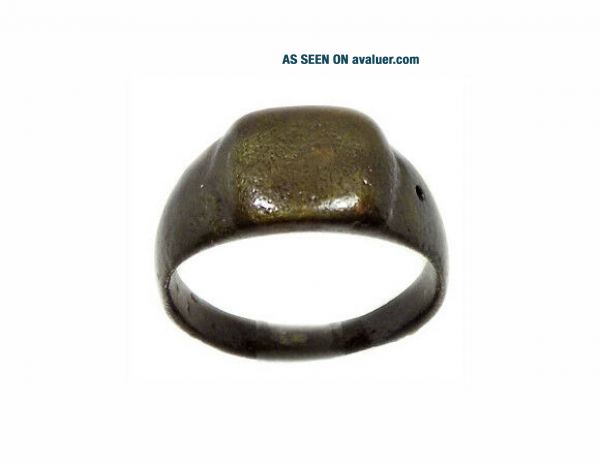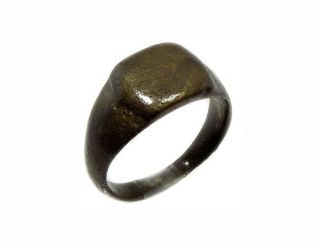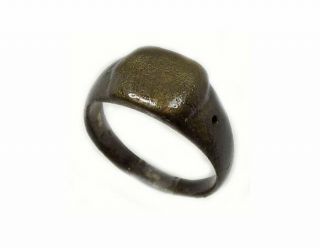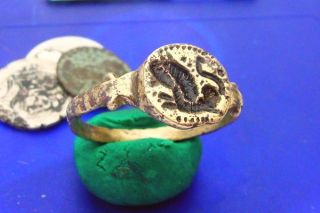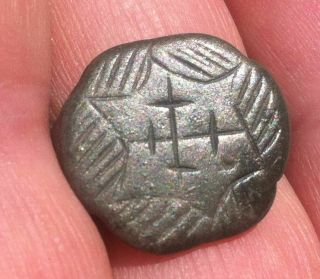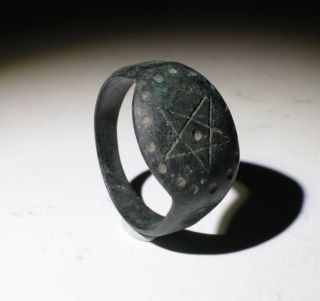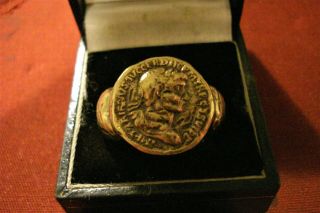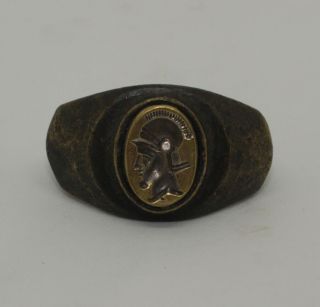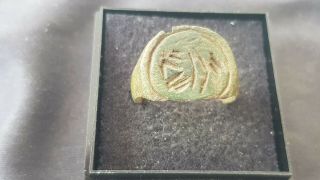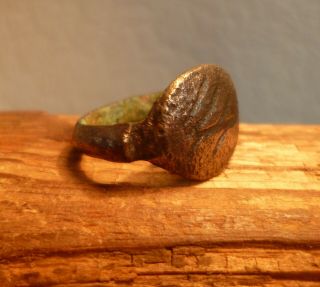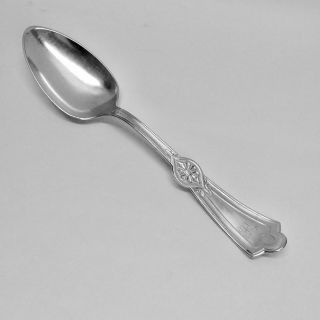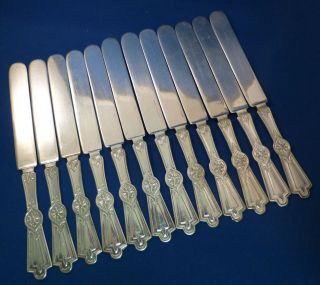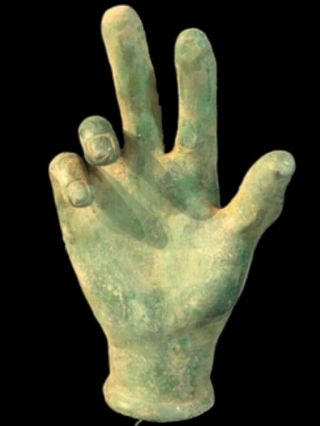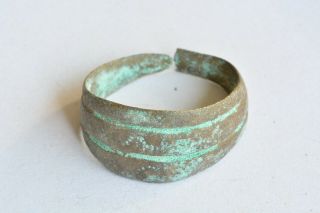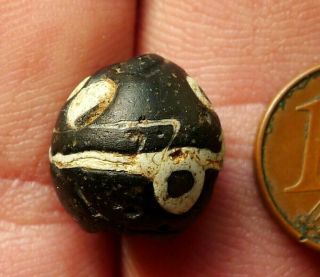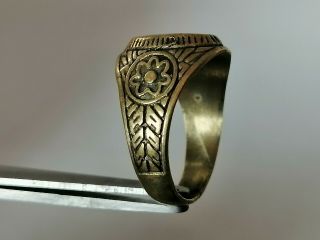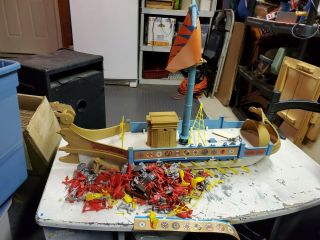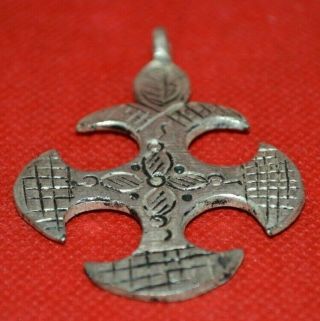Roman Bronze Ring Pannonia Hungary AD200 Large Handsome Heavy Size 12
Item History & Price
| Reference Number: Avaluer:27471493 | Material: Bronze |
| Featured Refinements: Roman Ring |
Very Elegant and Bold Size 12 Genuine Ancient Roman Bronze Ring 200 A.D. CLASSIFICATION: Ancient Roman Bronze Ring. ATTRIBUTION: Eastern Roman Empire (Provincial Pannonia – present-day Hungary), Second or Third Century A.D. SIZE/MEASUREMENTS: Fits ring size 12 (U.S.). Diameter: 27mm * 23 1/2mm (outer diameter); 21 3/4mm * 21 1/4mm (inner diameter). Bezel: 14mm (breadth) * 10 1/2mm (height) * 3mm (thickness...). Tapered Width Band: 9 1/2mm (at bezel) * 5 1/2mm (at sides) * 3 1/2mm (at back). Weight: 7.92 grams. CONDITION: Very good, completely intact, moderate wear, light porosity (surface pitting caused by contact with earth while buried). One inexplicable (ancient) drill hole. Professionally conserved. DETAIL: A handsome, nicely constructed Roman bronze ring with understated but very handsome features and heavy construction. The ring sports a large bezel which at one time bore an engraved design. However it is not possible to determine the form of the engraving as it has been worn smooth. Despite the fact that both the bezel and bands are entirely intact, the ring nonetheless shows lots of evidence of wear. In fact the extent of the wear is significant enough, particularly with respect to the bezel, that it suggests that the ring might have been worn during the lifetime of more than one owner…perhaps it was a family heirloom handed down between generations. Of course, the ring was designed and crafted with the idea that some ancient Roman citizen would wear it, so it should come as no great surprise that that’s exactly what they did. Nonetheless, even without an engraved design, the handsome, glossy oval bezel creates a very distinctive appearance, a classically timeless design. Though the ring obviously has been worn, it is nonetheless quite well preserved and very sturdy. As you can see, even sans engraving, the design of the ring is simple, but elegant. In addition to the physical wear to the ring, there is also a drill hole which you can see on one side of the ring. It’s very tiny, and does not go all the way through the band. We’re at a loss to explain how the drill hole might have been used, though it’s possible perhaps that some sort of embellishment may have been mounted to the ring (envision something like a golf tee with a decorative head), and then subsequently lost. At first we thought the hole to be a little spot of corrosion, but close examination reveals it to be a drill hole. The most likely explanation is that it was used to accommodate some sort of embellishment.. The fact that the ring evidences some degree of wear from ancient usage should not, however, be a source of disappointment. You must keep in mind that the ring was produced by an artisan and sold to a patron or consumer with the idea that the ring would be enjoyed and worn by the purchased. And without any regard to twenty-first century posterity, that precisely what happened! The original Roman owner of this ring wore it, enjoyed it, and probably never could have in his most delusional moment ever dreamed that almost 100 generations later the ring would still exist. The ring is of one-piece construction, much like a contemporary ring. The more archaic rings produced by Roman artisans were characteristically made in two pieces; an incomplete ring (a “shank”) with a separately crafted bezel which was brazed to the shank in order to assemble the ring. It should likewise come as no surprise that upon close inspection are detected the telltale signs that the ring spent thousands of years in the soil. Porosity is fine surface pitting (oxidation, corrosion) caused by extended burial in caustic soil. Many small ancient metal artifacts such as this are extensively disfigured and suffer substantial degradation as a consequence of the ordeal of being buried for millennia. It is not at all unusual to find metal artifacts decomposed to the point where they are not much more substantial than discolored patterns in the soil. Actually most smaller ancient artifacts such as this are so badly oxidized that oftentimes all that is left is a green (bronze) or red (iron) stain in the soil, or an artifact which crumbles in your hand. However this specimen is not so afflicted, and certainly has not been disfigured. To the inspection of the casual admirer, it simply looks like an ancient ring, nicely surfaced, no immediately discernible blemishes. You have to look very closely to detect the telltale signs indicating the ring was buried for millennia. This ring spent almost 2, 000 years buried, yet by good fortune there is only a very light degree of porosity evidenced. It happened to come to rest in very gentle soil conditions. The ring’s integrity is absolutely undiminished by the passage of time, and it has been professionally conserved. There are no cracks, chips, or other impairments to its integrity. The ring is quite sturdy, beautifully toned with a medium golden color very characteristic of ancient bronze, and quite handsome. The Romans were of course very fond of ornate personal jewelry including bracelets worn both on the forearm and upper arm, brooches, pendants, hair pins, earrings intricate fibulae and belt buckles, and of course, rings. This is an exceptional piece of Roman jewelry, a very handsome artifact, and eminently wearable. Aside from being significant to the history of ancient jewelry, it is also an evocative relic of one of the world’s greatest civilizations and than ancient world’s most significant military machine; the glory and light which was known as the “Roman Empire”. ROMAN HISTORY: One of the greatest civilizations of recorded history was the ancient Roman Empire. In exchange for a very modest amount of contemporary currency, you can possess a small part of that great civilization in the form of a 2, 000 year old piece of jewelry. The Roman civilization, in relative terms the greatest military power in the history of the world, was founded in the 8th century (B.C.). In the 4th Century (B.C.) the Romans were the dominant power on the Italian Peninsula, having defeated the Etruscans and Celts. In the 3rd Century (B.C.) the Romans conquered Sicily, and in the following century defeated Carthage, and controlled the Greece. Throughout the remainder of the 2nd Century (B.C.) the Roman Empire continued its gradual conquest of the Hellenistic (Greek Colonial) World by conquering Syria and Macedonia; and finally came to control Egypt in the 1st Century (B.C.). The pinnacle of Roman power was achieved in the 1st Century (A.D.) as Rome conquered much of Britain and Western Europe. For a brief time, the era of “Pax Romana”, a time of peace and consolidation reigned. Civilian emperors were the rule, and the culture flourished with a great deal of liberty enjoyed by the average Roman Citizen. However within 200 years the Roman Empire was in a state of steady decay, attacked by Germans, Goths, and Persians. In the 4th Century (A.D.) the Roman Empire was split between East and West. The Great Emperor Constantine temporarily arrested the decay of the Empire, but within a hundred years after his death the Persians captured Mesopotamia, Vandals infiltrated Gaul and Spain, and the Goths even sacked Rome itself. Most historians date the end of the Western Roman Empire to 476 (A.D.) when Emperor Romulus Augustus was deposed. However the Eastern Roman Empire (The Byzantine Empire) survived until the fall of Constantinople in 1453 A.D. At its peak, the Roman Empire stretched from Britain in the West, throughout most of Western, Central, and Eastern Europe, and into Asia Minor. Valuables such as coins and jewelry were commonly buried for safekeeping, and inevitably these ancient citizens would succumb to one of the many perils of the ancient world. Oftentimes the survivors of these individuals did not know where the valuables had been buried, and today, two thousand years later caches of coins and rings are still commonly uncovered throughout Europe and Asia Minor. Roman Soldiers oftentimes came to possess large quantities of “booty” from their plunderous conquests, and routinely buried their treasure for safekeeping before they went into battle. If they met their end in battle, most often the whereabouts of their treasure was likewise, unknown. Throughout history these treasures have been inadvertently discovered by farmers in their fields, uncovered by erosion, and the target of unsystematic searches by treasure seekers. With the introduction of metal detectors and other modern technologies to Eastern Europe in the past three or four decades, an amazing number of new finds are seeing the light of day two thousand years or more after they were originally hidden by their past owners. And with the liberalization of post-Soviet Eastern Europe, new markets have opened eager to share in these treasures of the Roman Empire. HISTORY OF BRONZE: Bronze is the name given to a wide range of alloys of copper, typically mixed in ancient times with zinc, tin, lead, or arsenic. The discovery of bronze enabled people to create metal objects which were better than previously possible. Tools, weapons, armor, and building materials made of bronze were harder and more durable than their stone and copper predecessors from the “Chalcolithic” (the “Copper Age”), i.e., about 7000-3500 B.C., and the Neolithic (“New Stone Age”), i.e. about 12000 to 7000 B.C.). Of particular significance were bronze agricultural implements, tools for cutting stone, and weapons. Culturally significant was bronze statuary, particularly that of the Romans and Greeks. The ancient Greeks and Romans had a long history of making statuary in bronze. Literally thousands of images of gods and heroes, victorious athletes, statesmen, and philosophers filled temples and sanctuaries, and stood in the public areas of major cities. In fact, the Statue of Zeus at Olympia and the Colossus of Rhodes are two of the Seven Wonders of the Ancient World. Initially bronze was made out of copper and arsenic. It was only later that tin was used, becoming (except in ancient Egypt) the sole type of bronze in the late 3rd millennium B.C. Tin-alloyed bronze was superior to arsenic-alloyed bronze in that the alloying process itself could more easily be controlled, the alloy was stronger and easier to cast, and unlike arsenic, tin is not toxic. Toxicity was a major factor in the production of arsenic bronze. Repeated exposure to arsenic fumes ultimately led to nerve damage in the limbs. Evidence of the long agony of Bronze Age metalsmiths came down to the ancient Greeks and Romans in the form of legend, as the Greek and Roman gods of metalsmiths, Greek Hephaestus and Roman Vulcan, were both lame. In practice historical bronze alloys are highly variable in composition, as most metalworkers probably used whatever scrap was to hand. In one instance of ancient bronze from Britain, analysis showed the bronze to contain a mixture of copper, zinc, tin, lead, nickel, iron, antimony, arsenic, and silver. Other advantages of bronze over iron include that bronze better resists corrosion, particularly seawater corrosion; bronze resists metal fatigue better than iron; and bronze is a better heat conductor (and thus is better suited for cooking vessels). However ancient bronze, unless conserved properly, is susceptible to “bronze disease”, wherein hydrochloric or hydrosulfuric acid is formed due to impurities (cuprous chloride or sulfur) found within the ancient bronze. Traditionally archaeology has maintained that the earliest bronze was produced by the Maikop, a proto-Indo-European, proto-Celtic culture of Caucasus prehistory around 3500 B.C. Recent evidence however suggests that the smelting of bronze might be as much as several thousand years older (bronze artifacts dating from about 4500 B.C. have been unearthed in Thailand). Shortly after the emergence of bronze technology in the Caucasus region, bronze technology emerged in ancient Mesopotamia (Sumer), Egypt, the Indus Valley Civilization of Northern India, the Aegean, the Caspian Steppes (Ukraine), the Southern Russia/Central Mongolia Region (the Altai Mountains), the Levant (Eastern Mediterranean), Anatolia (Turkey) and the Iranian Plateau. By the late third millennium B.C. many Western European Bronze Age Cultures had emerged. Some of the more notable were the Celtic cultures of Middle Europe stretching from Hungary to Poland and Germany, including the Urnfield, Lusatian, and (Iron Age Transitional) Hallstatt Cultures. The Shang in ancient China also developed a significant Bronze Age culture, noted for large bronze burial urns. The ancient Chinese were the first to cast bronze (using the “lost wax” technique) about 2200 B.C. Prior to that time all bronze items were forged. Though weapons and utilitarian items were produced in great numbers, the production of bronze in ancient China was especially noteworthy for ornamented ritualistic/religious vessels (urns, wine vessels, water pots, food containers, and musical instruments), many of immense size. Britain’s Bronze Age cultures included the Beaker, Wessex, Deverl, and Rimbury. Copper and tin ores are rarely found together, so the production of bronze has always involved trade. Cornwall was one of the most significant sources of tin not only for Britain, but exported throughout the Mediterranean. Other significant suppliers of tine were the Taurus Mountains of Anatolia (Turkey), as well as Spain. Enormous amounts of copper was produced from the Great Orme mine in North Wales, the island of Cyprus, the European Alps, and from the Sinai Peninsula and other nearby sites in the Levant. Though much of the raw minerals may have come from Britain, Spain, Anatolia, and the Sinai, it was the Aegean world which controlled the trade in bronze. The great seafaring Minoan Empire (about 2700 to 1450 B.C.) appears to have controlled, coordinated, and defended the trade. Tin and charcoal were imported into Cyprus, where locally mined copper was mined and alloyed with the tin from Britain. Indicative of the seafaring trade in the Eastern Mediterranean, a shipwreck from about 1300 B.C. off the Turkish coast revealed a ship carrying a ton of copper ingots, several dozen small tin ingots, new bronze tools, scrap metal, and a blacksmith's forge and tools (along with luxury trade goods from Africa). It appears that the Bronze Age collapsed with the fall of Minoan Empire, to be replaced by a Dark Age and the eventual rise of the Iron Age Myceneans (on mainland Greece). Evidence suggests that the precipitating event might have been the eruption of Thera (Santorini) and the ensuing tsunami, which was only about 40 miles north of Crete, the capital of the Minoan empire. Some archaeologists argue that it was Santorini itself which was the capitol city of the Minoan World. However where Crete or Santorini, it is known that the bread-basket of the Minoan trading empire, the area north of the Black Sea lost population, and thereafter many Minoan colony/client-states lost large populations to extreme famines or pestilence. Inasmuch as the Minoans were the principals of the tin/copper shipping network throughout the Mediterranean, the Bronze Age trade network is believed to have failed. The end of the Bronze Age and the rise of the Iron Age is normally associated with the disturbances created by large population disruptions in the 12th century B.C. The end of the Bronze Age saw the emergence of new technologies and civilizations which included the large-scale production of iron (and limited scale production of steel). Although iron was in many respects much inferior to bronze (and steel was inefficiently produced in very limited quantities), iron had the advantage that it could be produced using local resources during the dark ages that followed the Minoan collapse, and was very inexpensive when compared to the cost of producing bronze. Bronze was still a superior metal, resisting both corrosion and metal fatigue better than iron. And bronze was still used during the Iron Age, but for many purposes the weaker iron was sufficiently strong to serve in its place. As an example, Roman officers were equipped with bronze swords while foot soldiers had to make do with iron blades. Pliny the Elder, the famous first century Roman historian and naturalist, wrote about the reuse of scrap bronze and copper in Roman foundries, noting that the metals were recast as armor, weapons or articles for personal use, such as bronze mirrors. The melting and recasting foundries were located at the Italian port city of Brindisi. Located on the Adriatic coast, Brindisi was the terminus of the great Appian Way, the Roman road constructed to facilitate trade and military access throughout the Italian part of the Roman Empire. The city was the gateway for Romanpenetration into the eastern parts of her empire (Greece, the Eastern Mediterranean, the Black Sea Region, the Danubian Provinces, and eventually Mesopotamia). SHIPPING & RETURNS/REFUNDS: Your purchase will ordinarily be shipped within 48 hours of payment. We package as well as anyone in the business, with lots of protective padding and containers. All of our shipments are fully insured against loss, and our shipping rates include the cost of this coverage (through stamps.com, Shipsaver.com, the USPS, UPS, or Fed-Ex). International tracking is provided free by the USPS for certain countries, other countries are at additional cost. ADDITIONAL PURCHASES do receive a VERY LARGE discount, typically about $5 per item so as to reward you for the economies of combined shipping/insurance costs. We do offer U.S. Postal Service Priority Mail, Registered Mail, and Express Mail for both international and domestic shipments, as well United Parcel Service (UPS) and Federal Express (Fed-Ex). Please ask for a rate quotation. We will accept whatever payment method you are most comfortable with. If upon receipt of the item you are disappointed for any reason whatever, I offer a no questions asked 30-day return policy. Send it back, I will give you a complete refund of the purchase price; 1) less our original shipping/insurance costs, 2) less non-refundable PayPal/eBay payment processing fees. Please note that PayPal does NOT refund fees. Even if you “accidentally” purchase something and then cancel the purchase before it is shipped, PayPal will not refund their fees. So all refunds for any reason, without exception, do not include PayPal/eBay payment processing fees (typically between 3% and 5%) and shipping/insurance costs (if any). If you’re unhappy with PayPal and eBay’s “no fee refund” policy, and we are EXTREMELY unhappy, please voice your displeasure by contacting PayPal and/or eBay. We have no ability to influence, modify or waive PayPal or eBay policies. ABOUT US: We travel to Russia each year seeking antique gemstones and jewelry from one of the globe’s most prolific gemstone producing and cutting centers, the area between Chelyabinsk and Yekaterinburg, Russia. From all corners of Siberia, as well as from India, Ceylon, Burma and Siam, gemstones have for centuries gone to Yekaterinburg where they have been cut and incorporated into the fabulous jewelry for which the Czars and the royal families of Europe were famous for. My wife grew up and received a university education in the Southern Urals of Russia, just a few hours away from the mountains of Siberia, where alexandrite, diamond, emerald, sapphire, chrysoberyl, topaz, demantoid garnet, and many other rare and precious gemstones are produced. Though perhaps difficult to find in the USA, antique gemstones are commonly dismounted from old, broken settings – the gold reused – the gemstones recut and reset. Before these gorgeous antique gemstones are recut, we try to acquire the best of them in their original, antique, hand-finished state – most of them centuries old. We believe that the work created by these long-gone master artisans is worth protecting and preserving rather than destroying this heritage of antique gemstones by recutting the original work out of existence. That by preserving their work, in a sense, we are preserving their lives and the legacy they left for modern times. Far better to appreciate their craft than to destroy it with modern cutting. Not everyone agrees – fully 95% or more of the antique gemstones which come into these marketplaces are recut, and the heritage of the past lost. But if you agree with us that the past is worth protecting, and that past lives and the produce of those lives still matters today, consider buying an antique, hand cut, natural gemstone rather than one of the mass-produced machine cut (often synthetic or “lab produced”) gemstones which dominate the market today. Our interest in the fabulous history of Russian gemstones and the fabulous jewelry of the Czar’s led to further education and contacts in India, Ceylon, and Siam, other ancient centers of gemstone production and finishing. We have a number of “helpers” (family members, friends, and colleagues) in Russia and in India who act as eyes and ears for us year-round, and in reciprocity we donate a portion of our revenues to support educational institutions in Russia and India. Occasionally while in Russia, India, Siam, and Ceylon we will also find such good buys on unique contemporary gemstones and jewelry that we will purchase a few pieces to offer to our customers here in America. These are always offered clearly labeled as contemporary, and not antiques – just to avoid confusion. We can set most any antique gemstone you purchase from us in your choice of styles and metals ranging from rings to pendants to earrings and bracelets; in sterling silver, 14kt solid gold, and 14kt gold fill. When you purchase from us, you can count on quick shipping and careful, secure packaging. We would be happy to provide you with a certificate/guarantee of authenticity for any item you purchase from me. There is a $2 fee for mailing under separate cover. Please see our "ADDITIONAL TERMS OF SALE."
01622



